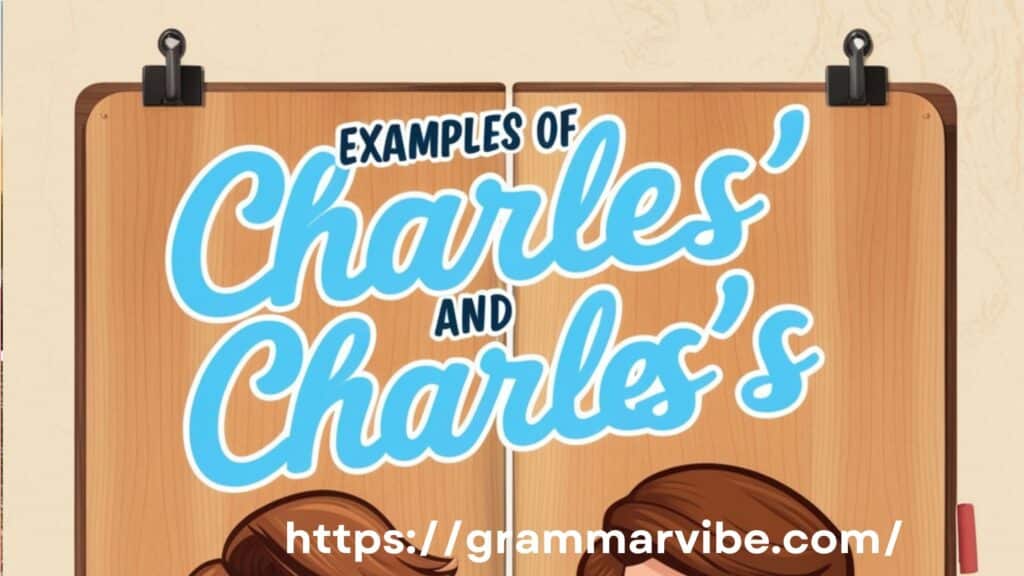When navigating the English language, possessive forms can often pose challenges, especially with names that end in “s,” like Charles. Should it be Charles’ or Charles’s?
We’ll dive deep into the nuances of these singular possessive forms, providing clear examples, usage scenarios, and guidelines to ensure you get it right every time.
Understanding Possessive Forms
Possessive forms are used to indicate ownership or association. When you want to show that something belongs to someone, you typically use a possessive form. In the case of names that end in “s,” such as Charles, the rules can vary depending on the style guide you adhere to.
Singular Possessive Explained
The singular possessive form indicates that something belongs to Charles. You can use both Charles’ and Charles’s depending on the style guide you prefer. Here’s a breakdown:
- Charles’: This form is commonly used in AP Style, which does not require an additional “s” after the apostrophe.
- Example: Charles’ car is parked outside.
- Charles’s: This form adds an “s” after the apostrophe and is typically preferred in the Chicago Manual of Style and modern English usage.
- Example: Charles’s dog is playful.
Both forms are acceptable, but consistency is key. Whichever style you choose, stick with it throughout your writing to avoid confusion.
You might also like: Friend’s or Friends’ or Friends
Examples of Charles’ and Charles’s

To clarify how these possessive forms work in practice, let’s look at some example sentences that highlight their usage.
Charles’
- Ownership:
- Example: “Charles’ birthday is in May.”
- This sentence indicates that the birthday belongs to Charles.
- Attribution:
- Example: “I borrowed Charles’ laptop to complete my assignment.”
- Here, the laptop is identified as belonging to Charles.
- Description:
- Example: “Charles’ insights on the project were invaluable.”
- This shows that the insights are associated with Charles.
- Location:
- Example: “We gathered at Charles’ house for the meeting.”
- This indicates the house where the meeting took place is owned by Charles.
- Events:
- Example: “Charles’ team won the championship last season.”
- The team that won is associated with Charles.
Charles’s
- Ownership:
- Example: “Charles’s bike is in the garage.”
- This shows that the bike belongs to Charles.
- Attribution:
- Example: “Have you seen Charles’s latest article?”
- This indicates the article is written by Charles.
- Description:
- Example: “Charles’s performance was outstanding last night.”
- The performance is being highlighted as belonging to Charles.
- Location:
- Example: “We enjoyed dinner at Charles’s favorite restaurant.”
- Here, the restaurant is identified as Charles’s preference.
- Events:
- Example: “Charles’s party was a huge success.”
- This indicates that the party was organized by Charles.
For your interest: Member’s or Members’ or Members
When to Use Each Form

Understanding when to use Charles’ versus Charles’s often depends on context and the audience. Here are a few points to consider:
- Audience: If you’re writing for a publication that adheres to AP Style, use Charles’. If your writing is more academic or follows the Chicago Manual of Style, opt for Charles’s.
- Consistency: Whatever form you choose, maintain consistency throughout your document. This helps readers follow along without getting confused.
For your interest: Ross’s or Ross’
Understanding Style Guides
When dealing with proper nouns like Charles, it’s crucial to follow the appropriate style guide to maintain professionalism and clarity in your writing. Each style guide has its own set of rules regarding possessives, and understanding these rules will help you communicate effectively.
AP Style vs. Chicago Manual of Style

- AP Style: This style emphasizes brevity and clarity. It suggests using Charles’ for possessives.
- Example: “Charles’ presentation was well-received.”
- Chicago Manual of Style: This style is more comprehensive and often accommodates various forms of English. It recommends using Charles’s for possessives.
- Example: “Charles’s ideas were innovative and creative.”
Implications of Style Choices
Your choice between Charles’ and Charles’s can reflect the tone and formality of your writing. For example, if you’re submitting an academic paper, sticking to Charles’s may convey a more polished and traditional tone. Conversely, if you’re crafting a news article or a blog post, Charles’ may feel more direct and approachable.
Explore further: Sister’s or Sisters’ or Sisters
The Importance of Consistency

Maintaining consistency in your writing is crucial, especially when dealing with possessives. Inconsistent use of possessive forms can confuse readers and undermine your credibility as a writer. Here are some tips to ensure you stay consistent:
- Choose a Style Guide: Select either AP or Chicago Manual of Style before starting your writing project. Once you’ve made your choice, refer to that guide for possessive forms.
- Use a Style Sheet: If you are working on a lengthy document, consider creating a style sheet that outlines how you will handle possessive forms, ensuring you refer back to it as you write.
- Proofread: After completing your document, review it for consistency in your possessive forms. Look for instances where you may have switched between Charles’ and Charles’s.
For your interest: Other Ways to Say “I Hope You Had a Great Vacation”
Common Mistakes to Avoid
Even seasoned writers can stumble when using possessive forms. Here are some common mistakes to watch out for:
- Mixing Forms: Avoid using both Charles’ and Charles’s interchangeably in the same document. This can confuse readers and undermine your credibility.
- Neglecting Context: Always consider the context when deciding which possessive form to use. Sometimes the surrounding words or phrases can guide your choice.
- Forgetting Apostrophes: Ensure you include the apostrophe correctly. Omitting it will change the meaning entirely. For example, “Charles dog” implies that Charles is a dog rather than indicating ownership of the dog.
The Role of Proper Nouns in English
Proper nouns refer to specific names of people, places, or organizations. Understanding how to handle the possessives of proper nouns like Charles is essential for clear communication. Here’s why:
- Clarity: Using the correct possessive form helps readers understand ownership immediately, enhancing the clarity of your writing.
- Professionalism: Proper use of possessives reflects well on your writing abilities. It demonstrates attention to detail and respect for language conventions.
- Reader Engagement: When you use possessive forms correctly, readers can focus on the content rather than getting distracted by grammatical errors.
Recommended reading: Employee’s or Employees’ or Employees
Key Takeaways
- Both forms are correct: Depending on your style guide, you can choose either Charles’ or Charles’s.
- Stay consistent: Whichever form you select, use it consistently throughout your document to maintain clarity.
- Understand your audience: Knowing which style guide your audience expects can help you choose the right possessive form.
Table of Possessive Forms
| Form | Example Sentence |
|---|---|
| Singular | Charles |
| Singular possessive | Charles’s / Charles’ |

Kyren Paul is an experienced blogger and the creative mind behind “Grammar Vibe.” With a passion for the nuances of English grammar, he brings clarity and insight to everyday language topics, making grammar accessible and engaging for readers of all levels.











Leave a Comment